Research Proposal: Globalization and the Rise of Terrorism
VerifiedAdded on 2022/08/11
|14
|3482
|26
Report
AI Summary
This research proposal examines the significant impact of globalization on the nature of terrorism, exploring its rise and spread across the globe. The study delves into the historical development of terrorism, analyzing how globalization has altered its dynamics, particularly focusing on the Middle East. It investigates the integration of nation-states, the movement of cultures, and the rise of extremist ideologies. The research utilizes secondary sources like books and academic journals to understand the adverse impacts of terrorism in a globalized world, including state-sponsored terrorism and the role of international players. The proposal highlights how technological advancements and cultural exchange, facilitated by globalization, have contributed to the spread of extremist ideas and the emergence of various forms of terrorism, emphasizing the need for international cooperation to mitigate these threats. The study aims to provide a comprehensive understanding of the complex relationship between globalization and terrorism.
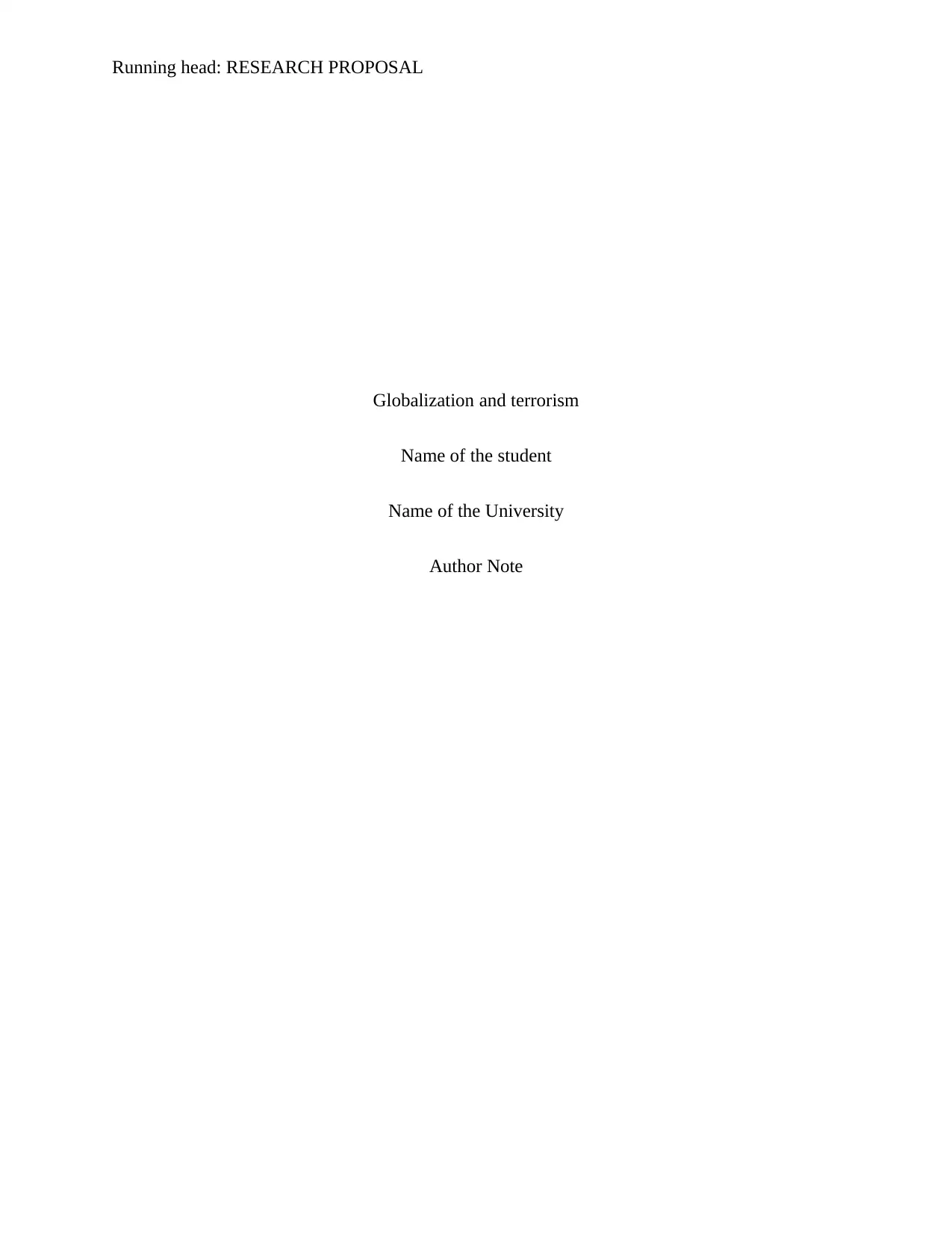
Running head: RESEARCH PROPOSAL
Globalization and terrorism
Name of the student
Name of the University
Author Note
Globalization and terrorism
Name of the student
Name of the University
Author Note
Paraphrase This Document
Need a fresh take? Get an instant paraphrase of this document with our AI Paraphraser
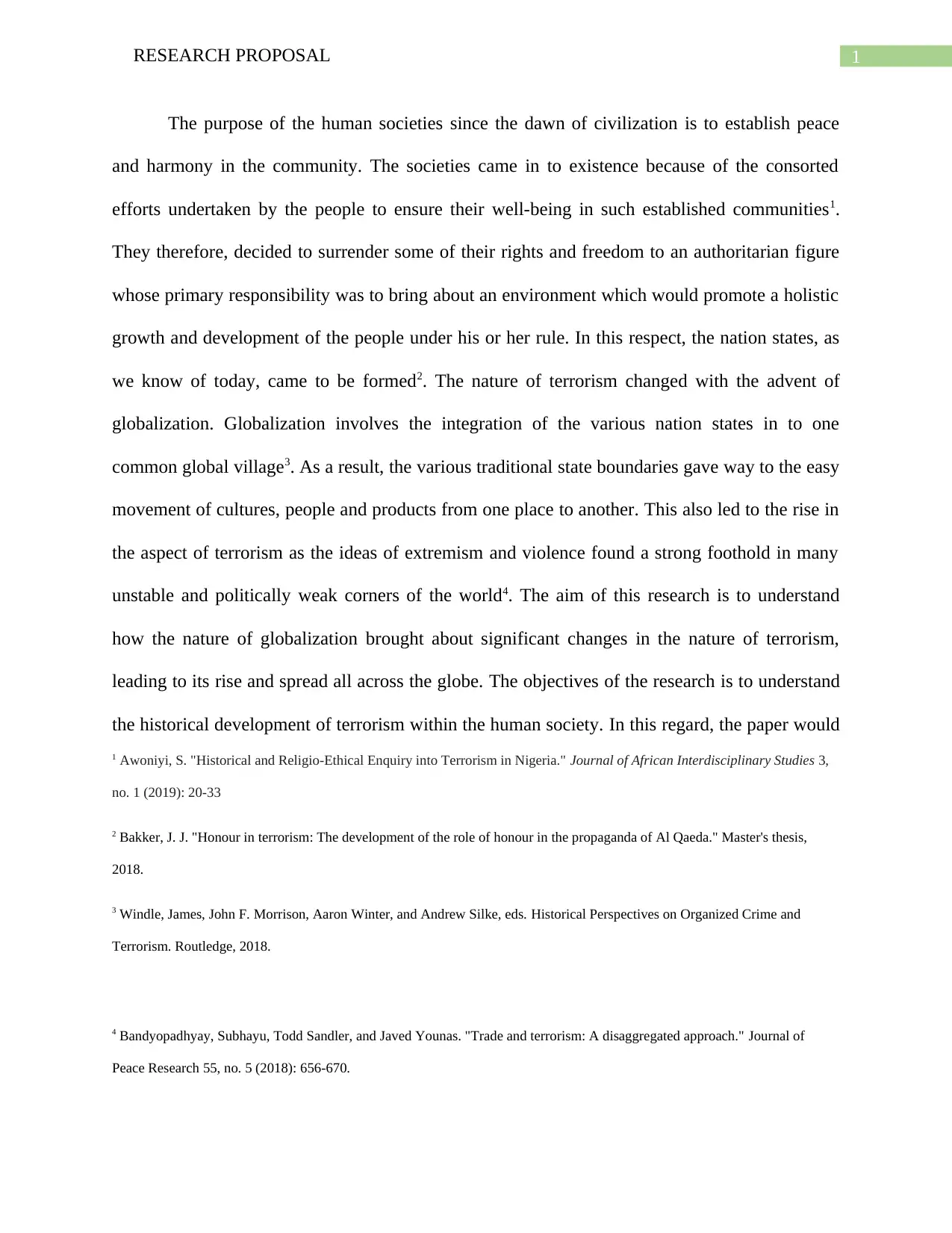
1RESEARCH PROPOSAL
The purpose of the human societies since the dawn of civilization is to establish peace
and harmony in the community. The societies came in to existence because of the consorted
efforts undertaken by the people to ensure their well-being in such established communities1.
They therefore, decided to surrender some of their rights and freedom to an authoritarian figure
whose primary responsibility was to bring about an environment which would promote a holistic
growth and development of the people under his or her rule. In this respect, the nation states, as
we know of today, came to be formed2. The nature of terrorism changed with the advent of
globalization. Globalization involves the integration of the various nation states in to one
common global village3. As a result, the various traditional state boundaries gave way to the easy
movement of cultures, people and products from one place to another. This also led to the rise in
the aspect of terrorism as the ideas of extremism and violence found a strong foothold in many
unstable and politically weak corners of the world4. The aim of this research is to understand
how the nature of globalization brought about significant changes in the nature of terrorism,
leading to its rise and spread all across the globe. The objectives of the research is to understand
the historical development of terrorism within the human society. In this regard, the paper would
1 Awoniyi, S. "Historical and Religio-Ethical Enquiry into Terrorism in Nigeria." Journal of African Interdisciplinary Studies 3,
no. 1 (2019): 20-33
2 Bakker, J. J. "Honour in terrorism: The development of the role of honour in the propaganda of Al Qaeda." Master's thesis,
2018.
3 Windle, James, John F. Morrison, Aaron Winter, and Andrew Silke, eds. Historical Perspectives on Organized Crime and
Terrorism. Routledge, 2018.
4 Bandyopadhyay, Subhayu, Todd Sandler, and Javed Younas. "Trade and terrorism: A disaggregated approach." Journal of
Peace Research 55, no. 5 (2018): 656-670.
The purpose of the human societies since the dawn of civilization is to establish peace
and harmony in the community. The societies came in to existence because of the consorted
efforts undertaken by the people to ensure their well-being in such established communities1.
They therefore, decided to surrender some of their rights and freedom to an authoritarian figure
whose primary responsibility was to bring about an environment which would promote a holistic
growth and development of the people under his or her rule. In this respect, the nation states, as
we know of today, came to be formed2. The nature of terrorism changed with the advent of
globalization. Globalization involves the integration of the various nation states in to one
common global village3. As a result, the various traditional state boundaries gave way to the easy
movement of cultures, people and products from one place to another. This also led to the rise in
the aspect of terrorism as the ideas of extremism and violence found a strong foothold in many
unstable and politically weak corners of the world4. The aim of this research is to understand
how the nature of globalization brought about significant changes in the nature of terrorism,
leading to its rise and spread all across the globe. The objectives of the research is to understand
the historical development of terrorism within the human society. In this regard, the paper would
1 Awoniyi, S. "Historical and Religio-Ethical Enquiry into Terrorism in Nigeria." Journal of African Interdisciplinary Studies 3,
no. 1 (2019): 20-33
2 Bakker, J. J. "Honour in terrorism: The development of the role of honour in the propaganda of Al Qaeda." Master's thesis,
2018.
3 Windle, James, John F. Morrison, Aaron Winter, and Andrew Silke, eds. Historical Perspectives on Organized Crime and
Terrorism. Routledge, 2018.
4 Bandyopadhyay, Subhayu, Todd Sandler, and Javed Younas. "Trade and terrorism: A disaggregated approach." Journal of
Peace Research 55, no. 5 (2018): 656-670.
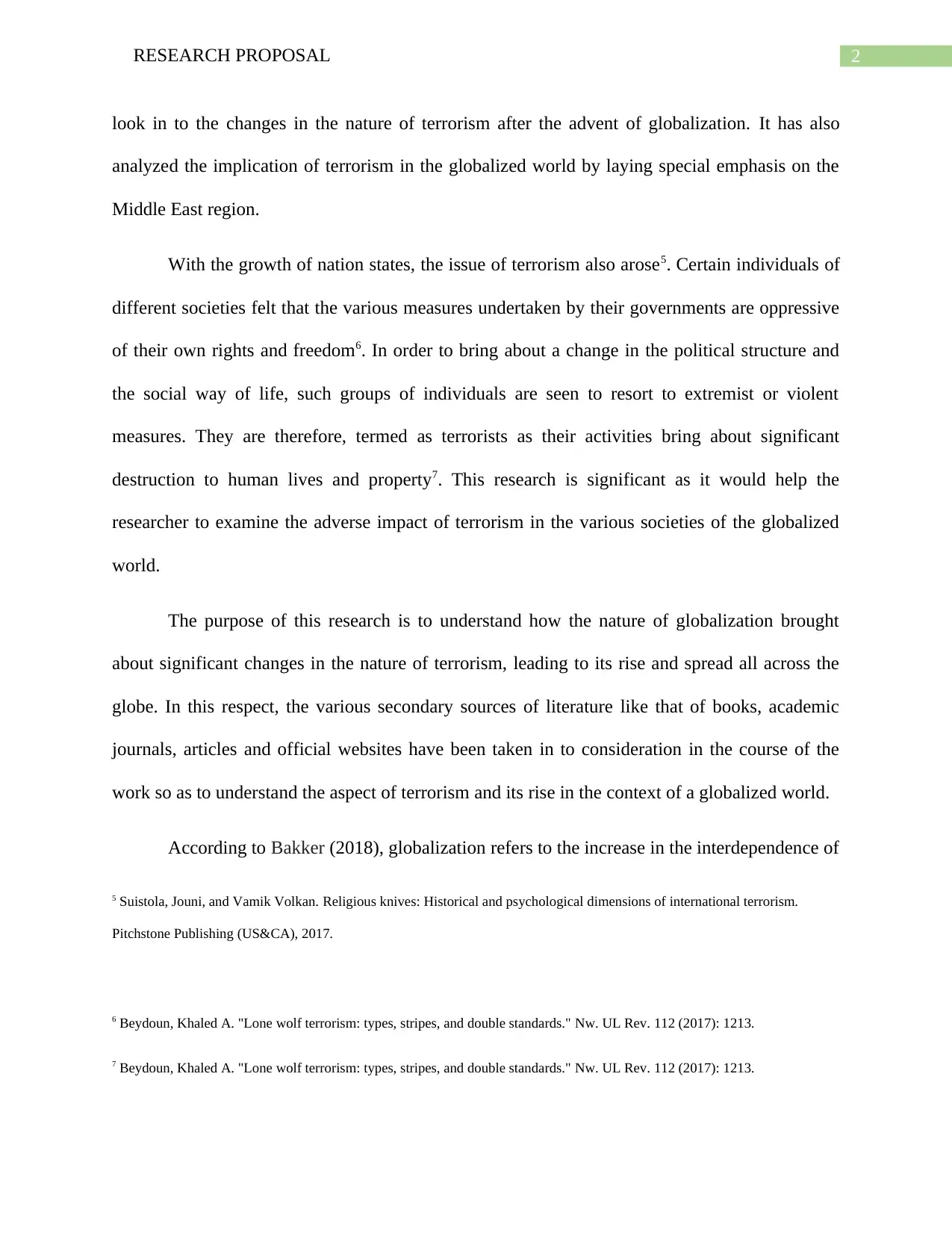
2RESEARCH PROPOSAL
look in to the changes in the nature of terrorism after the advent of globalization. It has also
analyzed the implication of terrorism in the globalized world by laying special emphasis on the
Middle East region.
With the growth of nation states, the issue of terrorism also arose5. Certain individuals of
different societies felt that the various measures undertaken by their governments are oppressive
of their own rights and freedom6. In order to bring about a change in the political structure and
the social way of life, such groups of individuals are seen to resort to extremist or violent
measures. They are therefore, termed as terrorists as their activities bring about significant
destruction to human lives and property7. This research is significant as it would help the
researcher to examine the adverse impact of terrorism in the various societies of the globalized
world.
The purpose of this research is to understand how the nature of globalization brought
about significant changes in the nature of terrorism, leading to its rise and spread all across the
globe. In this respect, the various secondary sources of literature like that of books, academic
journals, articles and official websites have been taken in to consideration in the course of the
work so as to understand the aspect of terrorism and its rise in the context of a globalized world.
According to Bakker (2018), globalization refers to the increase in the interdependence of
5 Suistola, Jouni, and Vamik Volkan. Religious knives: Historical and psychological dimensions of international terrorism.
Pitchstone Publishing (US&CA), 2017.
6 Beydoun, Khaled A. "Lone wolf terrorism: types, stripes, and double standards." Nw. UL Rev. 112 (2017): 1213.
7 Beydoun, Khaled A. "Lone wolf terrorism: types, stripes, and double standards." Nw. UL Rev. 112 (2017): 1213.
look in to the changes in the nature of terrorism after the advent of globalization. It has also
analyzed the implication of terrorism in the globalized world by laying special emphasis on the
Middle East region.
With the growth of nation states, the issue of terrorism also arose5. Certain individuals of
different societies felt that the various measures undertaken by their governments are oppressive
of their own rights and freedom6. In order to bring about a change in the political structure and
the social way of life, such groups of individuals are seen to resort to extremist or violent
measures. They are therefore, termed as terrorists as their activities bring about significant
destruction to human lives and property7. This research is significant as it would help the
researcher to examine the adverse impact of terrorism in the various societies of the globalized
world.
The purpose of this research is to understand how the nature of globalization brought
about significant changes in the nature of terrorism, leading to its rise and spread all across the
globe. In this respect, the various secondary sources of literature like that of books, academic
journals, articles and official websites have been taken in to consideration in the course of the
work so as to understand the aspect of terrorism and its rise in the context of a globalized world.
According to Bakker (2018), globalization refers to the increase in the interdependence of
5 Suistola, Jouni, and Vamik Volkan. Religious knives: Historical and psychological dimensions of international terrorism.
Pitchstone Publishing (US&CA), 2017.
6 Beydoun, Khaled A. "Lone wolf terrorism: types, stripes, and double standards." Nw. UL Rev. 112 (2017): 1213.
7 Beydoun, Khaled A. "Lone wolf terrorism: types, stripes, and double standards." Nw. UL Rev. 112 (2017): 1213.
⊘ This is a preview!⊘
Do you want full access?
Subscribe today to unlock all pages.

Trusted by 1+ million students worldwide
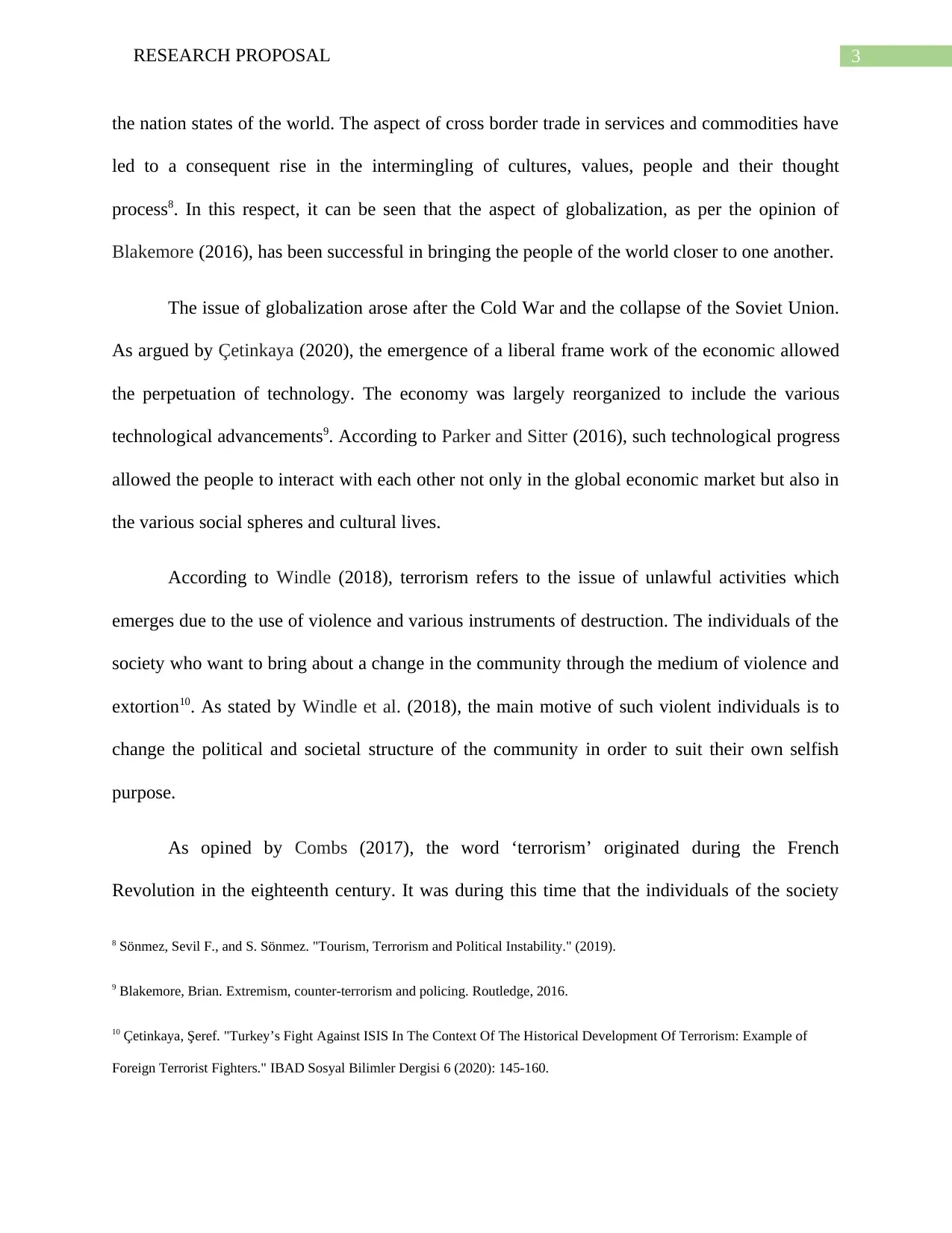
3RESEARCH PROPOSAL
the nation states of the world. The aspect of cross border trade in services and commodities have
led to a consequent rise in the intermingling of cultures, values, people and their thought
process8. In this respect, it can be seen that the aspect of globalization, as per the opinion of
Blakemore (2016), has been successful in bringing the people of the world closer to one another.
The issue of globalization arose after the Cold War and the collapse of the Soviet Union.
As argued by Çetinkaya (2020), the emergence of a liberal frame work of the economic allowed
the perpetuation of technology. The economy was largely reorganized to include the various
technological advancements9. According to Parker and Sitter (2016), such technological progress
allowed the people to interact with each other not only in the global economic market but also in
the various social spheres and cultural lives.
According to Windle (2018), terrorism refers to the issue of unlawful activities which
emerges due to the use of violence and various instruments of destruction. The individuals of the
society who want to bring about a change in the community through the medium of violence and
extortion10. As stated by Windle et al. (2018), the main motive of such violent individuals is to
change the political and societal structure of the community in order to suit their own selfish
purpose.
As opined by Combs (2017), the word ‘terrorism’ originated during the French
Revolution in the eighteenth century. It was during this time that the individuals of the society
8 Sönmez, Sevil F., and S. Sönmez. "Tourism, Terrorism and Political Instability." (2019).
9 Blakemore, Brian. Extremism, counter-terrorism and policing. Routledge, 2016.
10 Çetinkaya, Şeref. "Turkey’s Fight Against ISIS In The Context Of The Historical Development Of Terrorism: Example of
Foreign Terrorist Fighters." IBAD Sosyal Bilimler Dergisi 6 (2020): 145-160.
the nation states of the world. The aspect of cross border trade in services and commodities have
led to a consequent rise in the intermingling of cultures, values, people and their thought
process8. In this respect, it can be seen that the aspect of globalization, as per the opinion of
Blakemore (2016), has been successful in bringing the people of the world closer to one another.
The issue of globalization arose after the Cold War and the collapse of the Soviet Union.
As argued by Çetinkaya (2020), the emergence of a liberal frame work of the economic allowed
the perpetuation of technology. The economy was largely reorganized to include the various
technological advancements9. According to Parker and Sitter (2016), such technological progress
allowed the people to interact with each other not only in the global economic market but also in
the various social spheres and cultural lives.
According to Windle (2018), terrorism refers to the issue of unlawful activities which
emerges due to the use of violence and various instruments of destruction. The individuals of the
society who want to bring about a change in the community through the medium of violence and
extortion10. As stated by Windle et al. (2018), the main motive of such violent individuals is to
change the political and societal structure of the community in order to suit their own selfish
purpose.
As opined by Combs (2017), the word ‘terrorism’ originated during the French
Revolution in the eighteenth century. It was during this time that the individuals of the society
8 Sönmez, Sevil F., and S. Sönmez. "Tourism, Terrorism and Political Instability." (2019).
9 Blakemore, Brian. Extremism, counter-terrorism and policing. Routledge, 2016.
10 Çetinkaya, Şeref. "Turkey’s Fight Against ISIS In The Context Of The Historical Development Of Terrorism: Example of
Foreign Terrorist Fighters." IBAD Sosyal Bilimler Dergisi 6 (2020): 145-160.
Paraphrase This Document
Need a fresh take? Get an instant paraphrase of this document with our AI Paraphraser
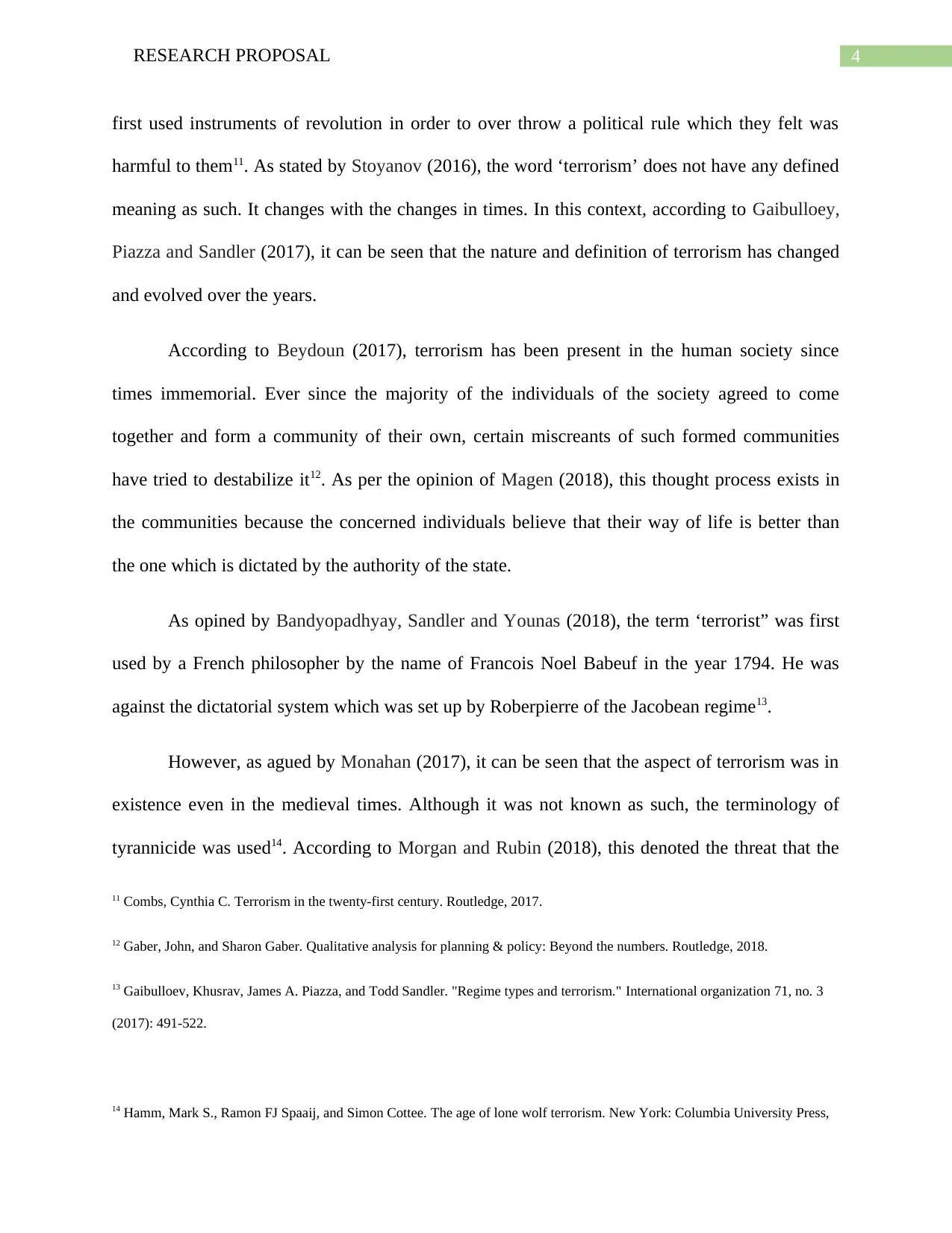
4RESEARCH PROPOSAL
first used instruments of revolution in order to over throw a political rule which they felt was
harmful to them11. As stated by Stoyanov (2016), the word ‘terrorism’ does not have any defined
meaning as such. It changes with the changes in times. In this context, according to Gaibulloey,
Piazza and Sandler (2017), it can be seen that the nature and definition of terrorism has changed
and evolved over the years.
According to Beydoun (2017), terrorism has been present in the human society since
times immemorial. Ever since the majority of the individuals of the society agreed to come
together and form a community of their own, certain miscreants of such formed communities
have tried to destabilize it12. As per the opinion of Magen (2018), this thought process exists in
the communities because the concerned individuals believe that their way of life is better than
the one which is dictated by the authority of the state.
As opined by Bandyopadhyay, Sandler and Younas (2018), the term ‘terrorist” was first
used by a French philosopher by the name of Francois Noel Babeuf in the year 1794. He was
against the dictatorial system which was set up by Roberpierre of the Jacobean regime13.
However, as agued by Monahan (2017), it can be seen that the aspect of terrorism was in
existence even in the medieval times. Although it was not known as such, the terminology of
tyrannicide was used14. According to Morgan and Rubin (2018), this denoted the threat that the
11 Combs, Cynthia C. Terrorism in the twenty-first century. Routledge, 2017.
12 Gaber, John, and Sharon Gaber. Qualitative analysis for planning & policy: Beyond the numbers. Routledge, 2018.
13 Gaibulloev, Khusrav, James A. Piazza, and Todd Sandler. "Regime types and terrorism." International organization 71, no. 3
(2017): 491-522.
14 Hamm, Mark S., Ramon FJ Spaaij, and Simon Cottee. The age of lone wolf terrorism. New York: Columbia University Press,
first used instruments of revolution in order to over throw a political rule which they felt was
harmful to them11. As stated by Stoyanov (2016), the word ‘terrorism’ does not have any defined
meaning as such. It changes with the changes in times. In this context, according to Gaibulloey,
Piazza and Sandler (2017), it can be seen that the nature and definition of terrorism has changed
and evolved over the years.
According to Beydoun (2017), terrorism has been present in the human society since
times immemorial. Ever since the majority of the individuals of the society agreed to come
together and form a community of their own, certain miscreants of such formed communities
have tried to destabilize it12. As per the opinion of Magen (2018), this thought process exists in
the communities because the concerned individuals believe that their way of life is better than
the one which is dictated by the authority of the state.
As opined by Bandyopadhyay, Sandler and Younas (2018), the term ‘terrorist” was first
used by a French philosopher by the name of Francois Noel Babeuf in the year 1794. He was
against the dictatorial system which was set up by Roberpierre of the Jacobean regime13.
However, as agued by Monahan (2017), it can be seen that the aspect of terrorism was in
existence even in the medieval times. Although it was not known as such, the terminology of
tyrannicide was used14. According to Morgan and Rubin (2018), this denoted the threat that the
11 Combs, Cynthia C. Terrorism in the twenty-first century. Routledge, 2017.
12 Gaber, John, and Sharon Gaber. Qualitative analysis for planning & policy: Beyond the numbers. Routledge, 2018.
13 Gaibulloev, Khusrav, James A. Piazza, and Todd Sandler. "Regime types and terrorism." International organization 71, no. 3
(2017): 491-522.
14 Hamm, Mark S., Ramon FJ Spaaij, and Simon Cottee. The age of lone wolf terrorism. New York: Columbia University Press,
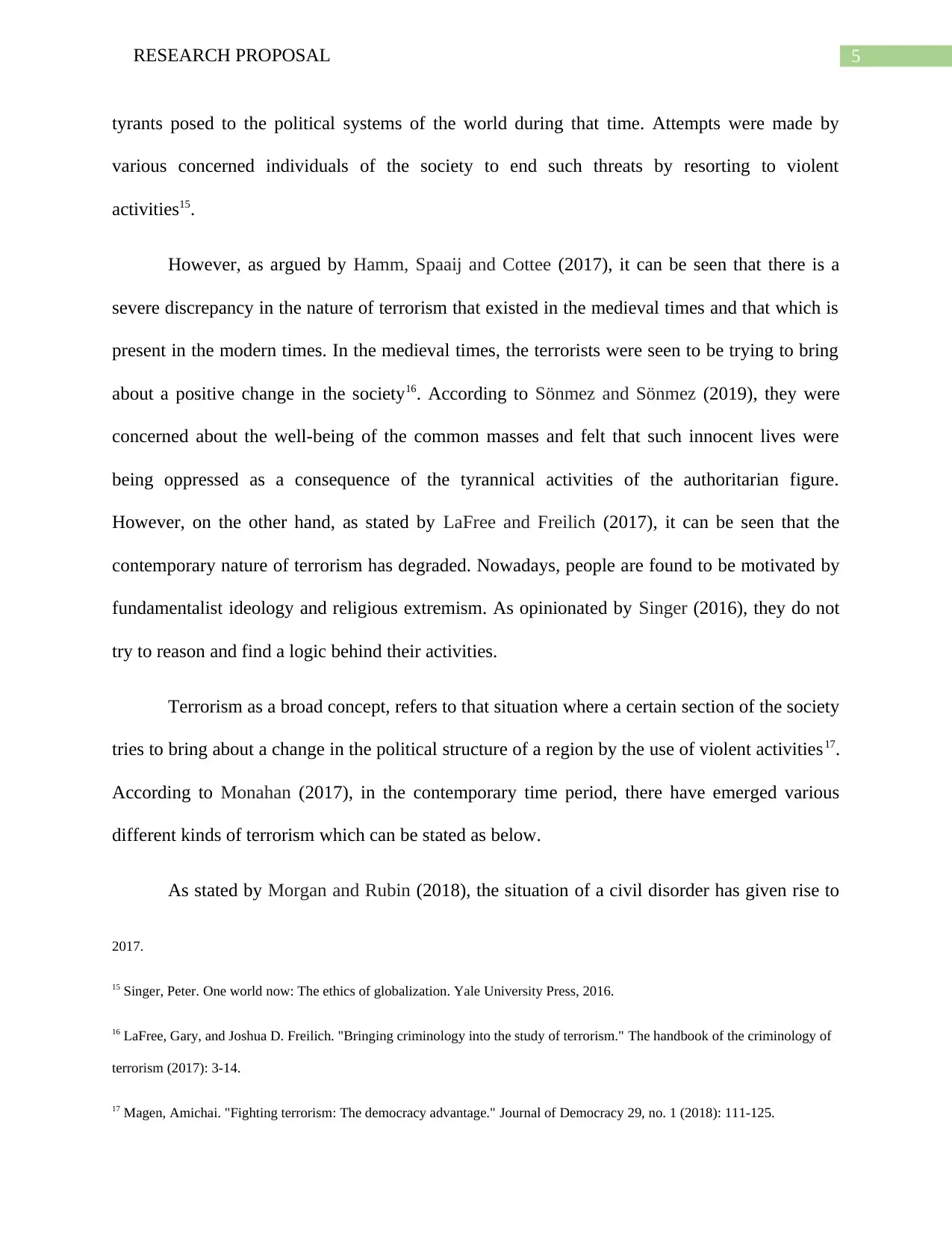
5RESEARCH PROPOSAL
tyrants posed to the political systems of the world during that time. Attempts were made by
various concerned individuals of the society to end such threats by resorting to violent
activities15.
However, as argued by Hamm, Spaaij and Cottee (2017), it can be seen that there is a
severe discrepancy in the nature of terrorism that existed in the medieval times and that which is
present in the modern times. In the medieval times, the terrorists were seen to be trying to bring
about a positive change in the society16. According to Sönmez and Sönmez (2019), they were
concerned about the well-being of the common masses and felt that such innocent lives were
being oppressed as a consequence of the tyrannical activities of the authoritarian figure.
However, on the other hand, as stated by LaFree and Freilich (2017), it can be seen that the
contemporary nature of terrorism has degraded. Nowadays, people are found to be motivated by
fundamentalist ideology and religious extremism. As opinionated by Singer (2016), they do not
try to reason and find a logic behind their activities.
Terrorism as a broad concept, refers to that situation where a certain section of the society
tries to bring about a change in the political structure of a region by the use of violent activities17.
According to Monahan (2017), in the contemporary time period, there have emerged various
different kinds of terrorism which can be stated as below.
As stated by Morgan and Rubin (2018), the situation of a civil disorder has given rise to
2017.
15 Singer, Peter. One world now: The ethics of globalization. Yale University Press, 2016.
16 LaFree, Gary, and Joshua D. Freilich. "Bringing criminology into the study of terrorism." The handbook of the criminology of
terrorism (2017): 3-14.
17 Magen, Amichai. "Fighting terrorism: The democracy advantage." Journal of Democracy 29, no. 1 (2018): 111-125.
tyrants posed to the political systems of the world during that time. Attempts were made by
various concerned individuals of the society to end such threats by resorting to violent
activities15.
However, as argued by Hamm, Spaaij and Cottee (2017), it can be seen that there is a
severe discrepancy in the nature of terrorism that existed in the medieval times and that which is
present in the modern times. In the medieval times, the terrorists were seen to be trying to bring
about a positive change in the society16. According to Sönmez and Sönmez (2019), they were
concerned about the well-being of the common masses and felt that such innocent lives were
being oppressed as a consequence of the tyrannical activities of the authoritarian figure.
However, on the other hand, as stated by LaFree and Freilich (2017), it can be seen that the
contemporary nature of terrorism has degraded. Nowadays, people are found to be motivated by
fundamentalist ideology and religious extremism. As opinionated by Singer (2016), they do not
try to reason and find a logic behind their activities.
Terrorism as a broad concept, refers to that situation where a certain section of the society
tries to bring about a change in the political structure of a region by the use of violent activities17.
According to Monahan (2017), in the contemporary time period, there have emerged various
different kinds of terrorism which can be stated as below.
As stated by Morgan and Rubin (2018), the situation of a civil disorder has given rise to
2017.
15 Singer, Peter. One world now: The ethics of globalization. Yale University Press, 2016.
16 LaFree, Gary, and Joshua D. Freilich. "Bringing criminology into the study of terrorism." The handbook of the criminology of
terrorism (2017): 3-14.
17 Magen, Amichai. "Fighting terrorism: The democracy advantage." Journal of Democracy 29, no. 1 (2018): 111-125.
⊘ This is a preview!⊘
Do you want full access?
Subscribe today to unlock all pages.

Trusted by 1+ million students worldwide
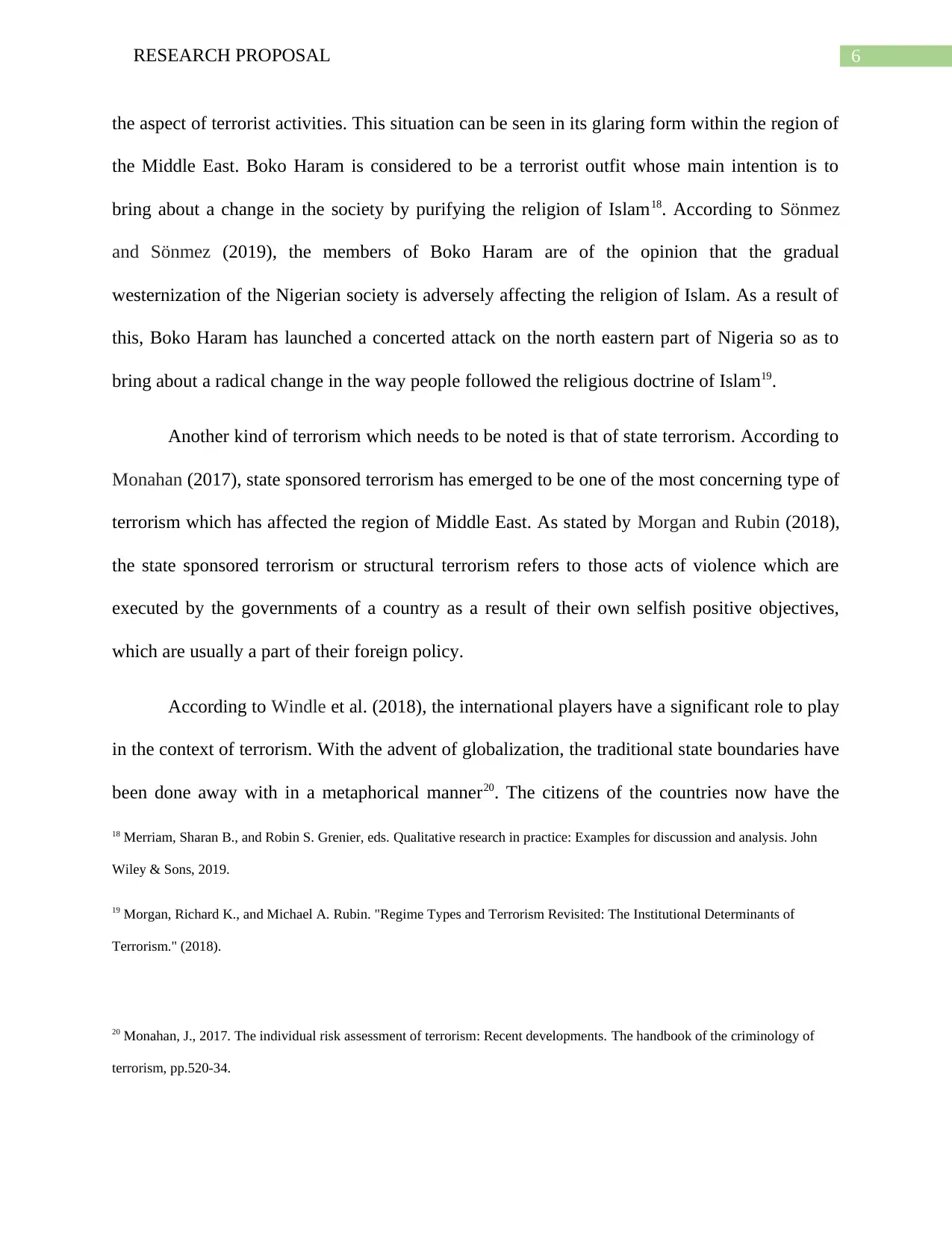
6RESEARCH PROPOSAL
the aspect of terrorist activities. This situation can be seen in its glaring form within the region of
the Middle East. Boko Haram is considered to be a terrorist outfit whose main intention is to
bring about a change in the society by purifying the religion of Islam18. According to Sönmez
and Sönmez (2019), the members of Boko Haram are of the opinion that the gradual
westernization of the Nigerian society is adversely affecting the religion of Islam. As a result of
this, Boko Haram has launched a concerted attack on the north eastern part of Nigeria so as to
bring about a radical change in the way people followed the religious doctrine of Islam19.
Another kind of terrorism which needs to be noted is that of state terrorism. According to
Monahan (2017), state sponsored terrorism has emerged to be one of the most concerning type of
terrorism which has affected the region of Middle East. As stated by Morgan and Rubin (2018),
the state sponsored terrorism or structural terrorism refers to those acts of violence which are
executed by the governments of a country as a result of their own selfish positive objectives,
which are usually a part of their foreign policy.
According to Windle et al. (2018), the international players have a significant role to play
in the context of terrorism. With the advent of globalization, the traditional state boundaries have
been done away with in a metaphorical manner20. The citizens of the countries now have the
18 Merriam, Sharan B., and Robin S. Grenier, eds. Qualitative research in practice: Examples for discussion and analysis. John
Wiley & Sons, 2019.
19 Morgan, Richard K., and Michael A. Rubin. "Regime Types and Terrorism Revisited: The Institutional Determinants of
Terrorism." (2018).
20 Monahan, J., 2017. The individual risk assessment of terrorism: Recent developments. The handbook of the criminology of
terrorism, pp.520-34.
the aspect of terrorist activities. This situation can be seen in its glaring form within the region of
the Middle East. Boko Haram is considered to be a terrorist outfit whose main intention is to
bring about a change in the society by purifying the religion of Islam18. According to Sönmez
and Sönmez (2019), the members of Boko Haram are of the opinion that the gradual
westernization of the Nigerian society is adversely affecting the religion of Islam. As a result of
this, Boko Haram has launched a concerted attack on the north eastern part of Nigeria so as to
bring about a radical change in the way people followed the religious doctrine of Islam19.
Another kind of terrorism which needs to be noted is that of state terrorism. According to
Monahan (2017), state sponsored terrorism has emerged to be one of the most concerning type of
terrorism which has affected the region of Middle East. As stated by Morgan and Rubin (2018),
the state sponsored terrorism or structural terrorism refers to those acts of violence which are
executed by the governments of a country as a result of their own selfish positive objectives,
which are usually a part of their foreign policy.
According to Windle et al. (2018), the international players have a significant role to play
in the context of terrorism. With the advent of globalization, the traditional state boundaries have
been done away with in a metaphorical manner20. The citizens of the countries now have the
18 Merriam, Sharan B., and Robin S. Grenier, eds. Qualitative research in practice: Examples for discussion and analysis. John
Wiley & Sons, 2019.
19 Morgan, Richard K., and Michael A. Rubin. "Regime Types and Terrorism Revisited: The Institutional Determinants of
Terrorism." (2018).
20 Monahan, J., 2017. The individual risk assessment of terrorism: Recent developments. The handbook of the criminology of
terrorism, pp.520-34.
Paraphrase This Document
Need a fresh take? Get an instant paraphrase of this document with our AI Paraphraser
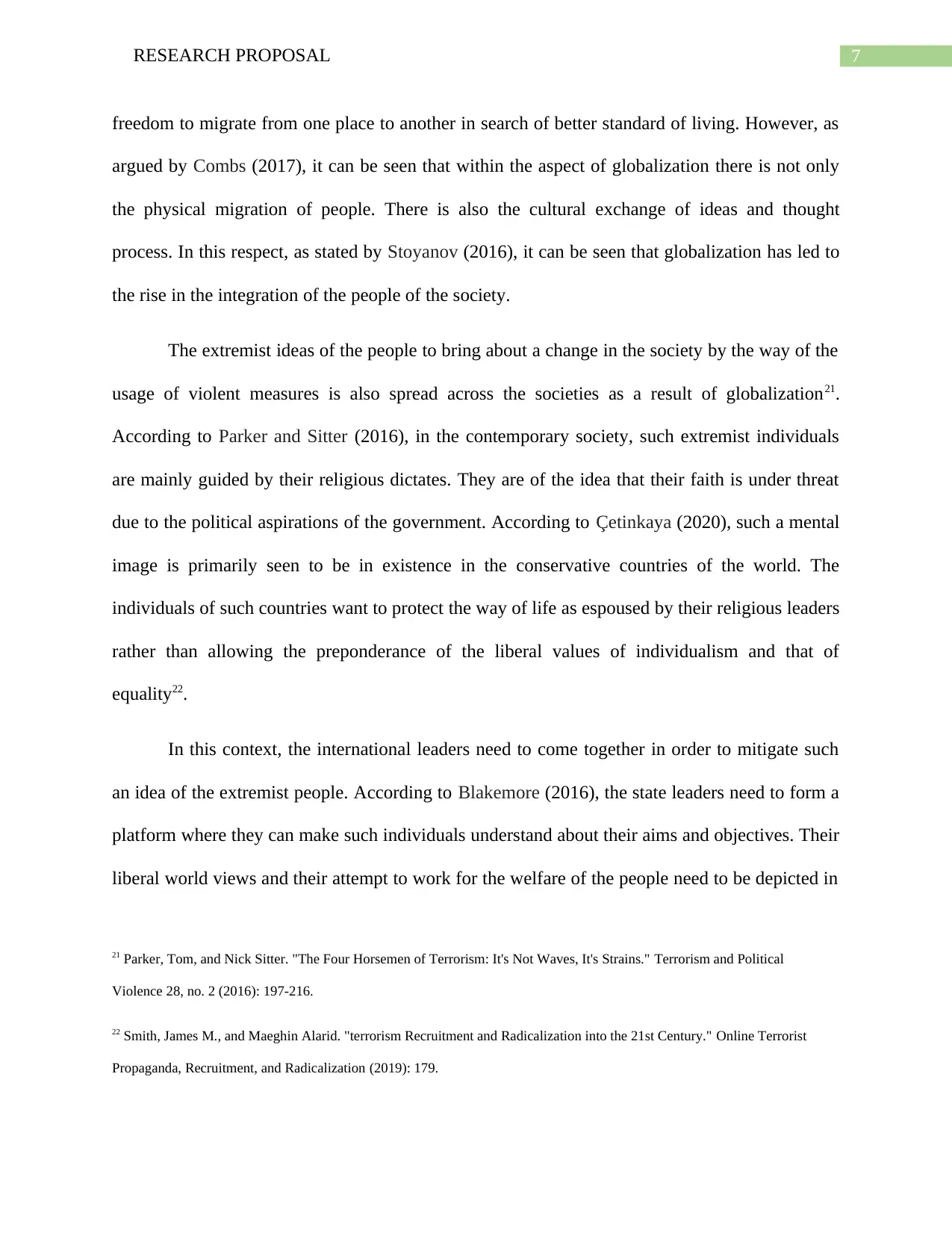
7RESEARCH PROPOSAL
freedom to migrate from one place to another in search of better standard of living. However, as
argued by Combs (2017), it can be seen that within the aspect of globalization there is not only
the physical migration of people. There is also the cultural exchange of ideas and thought
process. In this respect, as stated by Stoyanov (2016), it can be seen that globalization has led to
the rise in the integration of the people of the society.
The extremist ideas of the people to bring about a change in the society by the way of the
usage of violent measures is also spread across the societies as a result of globalization21.
According to Parker and Sitter (2016), in the contemporary society, such extremist individuals
are mainly guided by their religious dictates. They are of the idea that their faith is under threat
due to the political aspirations of the government. According to Çetinkaya (2020), such a mental
image is primarily seen to be in existence in the conservative countries of the world. The
individuals of such countries want to protect the way of life as espoused by their religious leaders
rather than allowing the preponderance of the liberal values of individualism and that of
equality22.
In this context, the international leaders need to come together in order to mitigate such
an idea of the extremist people. According to Blakemore (2016), the state leaders need to form a
platform where they can make such individuals understand about their aims and objectives. Their
liberal world views and their attempt to work for the welfare of the people need to be depicted in
21 Parker, Tom, and Nick Sitter. "The Four Horsemen of Terrorism: It's Not Waves, It's Strains." Terrorism and Political
Violence 28, no. 2 (2016): 197-216.
22 Smith, James M., and Maeghin Alarid. "terrorism Recruitment and Radicalization into the 21st Century." Online Terrorist
Propaganda, Recruitment, and Radicalization (2019): 179.
freedom to migrate from one place to another in search of better standard of living. However, as
argued by Combs (2017), it can be seen that within the aspect of globalization there is not only
the physical migration of people. There is also the cultural exchange of ideas and thought
process. In this respect, as stated by Stoyanov (2016), it can be seen that globalization has led to
the rise in the integration of the people of the society.
The extremist ideas of the people to bring about a change in the society by the way of the
usage of violent measures is also spread across the societies as a result of globalization21.
According to Parker and Sitter (2016), in the contemporary society, such extremist individuals
are mainly guided by their religious dictates. They are of the idea that their faith is under threat
due to the political aspirations of the government. According to Çetinkaya (2020), such a mental
image is primarily seen to be in existence in the conservative countries of the world. The
individuals of such countries want to protect the way of life as espoused by their religious leaders
rather than allowing the preponderance of the liberal values of individualism and that of
equality22.
In this context, the international leaders need to come together in order to mitigate such
an idea of the extremist people. According to Blakemore (2016), the state leaders need to form a
platform where they can make such individuals understand about their aims and objectives. Their
liberal world views and their attempt to work for the welfare of the people need to be depicted in
21 Parker, Tom, and Nick Sitter. "The Four Horsemen of Terrorism: It's Not Waves, It's Strains." Terrorism and Political
Violence 28, no. 2 (2016): 197-216.
22 Smith, James M., and Maeghin Alarid. "terrorism Recruitment and Radicalization into the 21st Century." Online Terrorist
Propaganda, Recruitment, and Radicalization (2019): 179.
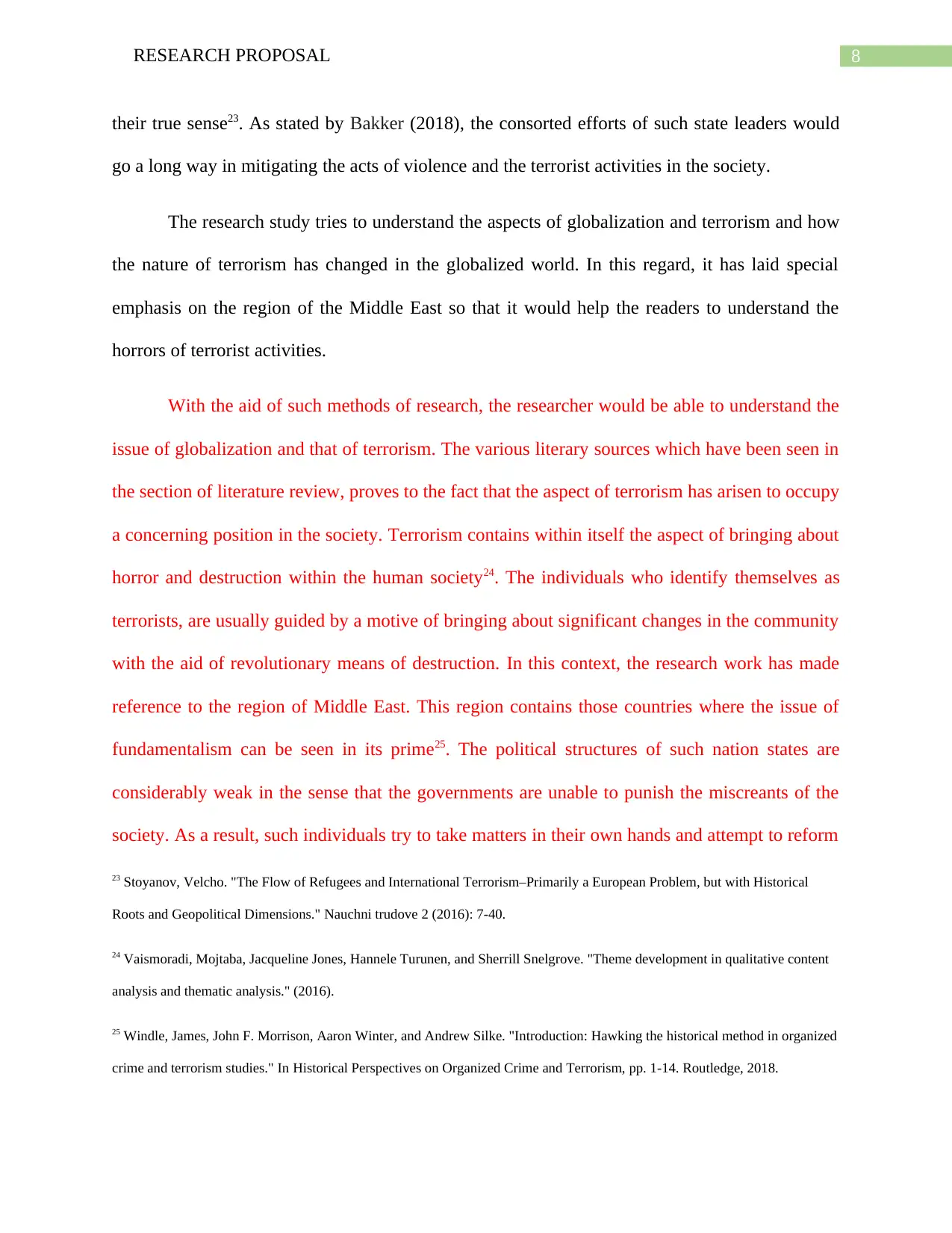
8RESEARCH PROPOSAL
their true sense23. As stated by Bakker (2018), the consorted efforts of such state leaders would
go a long way in mitigating the acts of violence and the terrorist activities in the society.
The research study tries to understand the aspects of globalization and terrorism and how
the nature of terrorism has changed in the globalized world. In this regard, it has laid special
emphasis on the region of the Middle East so that it would help the readers to understand the
horrors of terrorist activities.
With the aid of such methods of research, the researcher would be able to understand the
issue of globalization and that of terrorism. The various literary sources which have been seen in
the section of literature review, proves to the fact that the aspect of terrorism has arisen to occupy
a concerning position in the society. Terrorism contains within itself the aspect of bringing about
horror and destruction within the human society24. The individuals who identify themselves as
terrorists, are usually guided by a motive of bringing about significant changes in the community
with the aid of revolutionary means of destruction. In this context, the research work has made
reference to the region of Middle East. This region contains those countries where the issue of
fundamentalism can be seen in its prime25. The political structures of such nation states are
considerably weak in the sense that the governments are unable to punish the miscreants of the
society. As a result, such individuals try to take matters in their own hands and attempt to reform
23 Stoyanov, Velcho. "The Flow of Refugees and International Terrorism–Primarily a European Problem, but with Historical
Roots and Geopolitical Dimensions." Nauchni trudove 2 (2016): 7-40.
24 Vaismoradi, Mojtaba, Jacqueline Jones, Hannele Turunen, and Sherrill Snelgrove. "Theme development in qualitative content
analysis and thematic analysis." (2016).
25 Windle, James, John F. Morrison, Aaron Winter, and Andrew Silke. "Introduction: Hawking the historical method in organized
crime and terrorism studies." In Historical Perspectives on Organized Crime and Terrorism, pp. 1-14. Routledge, 2018.
their true sense23. As stated by Bakker (2018), the consorted efforts of such state leaders would
go a long way in mitigating the acts of violence and the terrorist activities in the society.
The research study tries to understand the aspects of globalization and terrorism and how
the nature of terrorism has changed in the globalized world. In this regard, it has laid special
emphasis on the region of the Middle East so that it would help the readers to understand the
horrors of terrorist activities.
With the aid of such methods of research, the researcher would be able to understand the
issue of globalization and that of terrorism. The various literary sources which have been seen in
the section of literature review, proves to the fact that the aspect of terrorism has arisen to occupy
a concerning position in the society. Terrorism contains within itself the aspect of bringing about
horror and destruction within the human society24. The individuals who identify themselves as
terrorists, are usually guided by a motive of bringing about significant changes in the community
with the aid of revolutionary means of destruction. In this context, the research work has made
reference to the region of Middle East. This region contains those countries where the issue of
fundamentalism can be seen in its prime25. The political structures of such nation states are
considerably weak in the sense that the governments are unable to punish the miscreants of the
society. As a result, such individuals try to take matters in their own hands and attempt to reform
23 Stoyanov, Velcho. "The Flow of Refugees and International Terrorism–Primarily a European Problem, but with Historical
Roots and Geopolitical Dimensions." Nauchni trudove 2 (2016): 7-40.
24 Vaismoradi, Mojtaba, Jacqueline Jones, Hannele Turunen, and Sherrill Snelgrove. "Theme development in qualitative content
analysis and thematic analysis." (2016).
25 Windle, James, John F. Morrison, Aaron Winter, and Andrew Silke. "Introduction: Hawking the historical method in organized
crime and terrorism studies." In Historical Perspectives on Organized Crime and Terrorism, pp. 1-14. Routledge, 2018.
⊘ This is a preview!⊘
Do you want full access?
Subscribe today to unlock all pages.

Trusted by 1+ million students worldwide
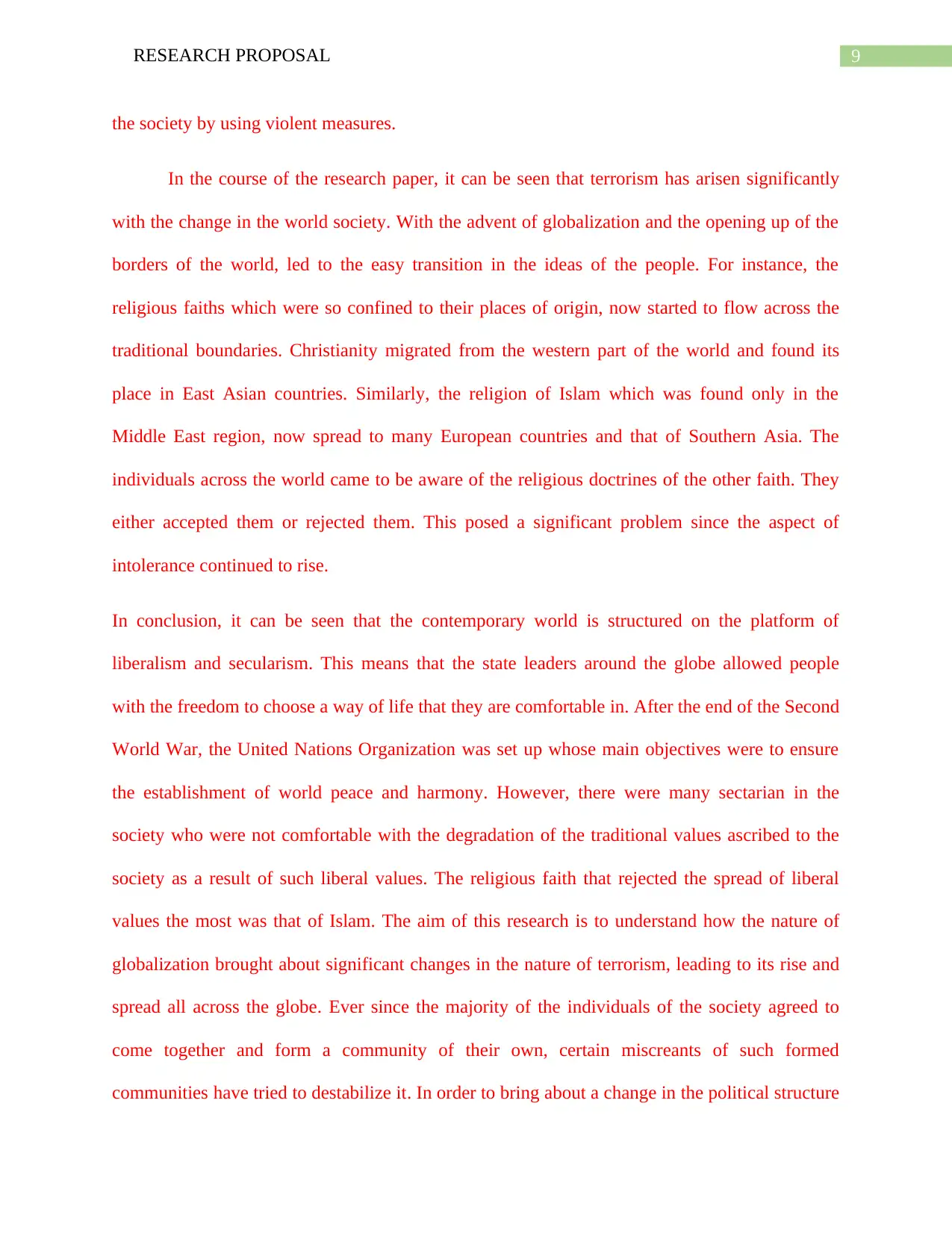
9RESEARCH PROPOSAL
the society by using violent measures.
In the course of the research paper, it can be seen that terrorism has arisen significantly
with the change in the world society. With the advent of globalization and the opening up of the
borders of the world, led to the easy transition in the ideas of the people. For instance, the
religious faiths which were so confined to their places of origin, now started to flow across the
traditional boundaries. Christianity migrated from the western part of the world and found its
place in East Asian countries. Similarly, the religion of Islam which was found only in the
Middle East region, now spread to many European countries and that of Southern Asia. The
individuals across the world came to be aware of the religious doctrines of the other faith. They
either accepted them or rejected them. This posed a significant problem since the aspect of
intolerance continued to rise.
In conclusion, it can be seen that the contemporary world is structured on the platform of
liberalism and secularism. This means that the state leaders around the globe allowed people
with the freedom to choose a way of life that they are comfortable in. After the end of the Second
World War, the United Nations Organization was set up whose main objectives were to ensure
the establishment of world peace and harmony. However, there were many sectarian in the
society who were not comfortable with the degradation of the traditional values ascribed to the
society as a result of such liberal values. The religious faith that rejected the spread of liberal
values the most was that of Islam. The aim of this research is to understand how the nature of
globalization brought about significant changes in the nature of terrorism, leading to its rise and
spread all across the globe. Ever since the majority of the individuals of the society agreed to
come together and form a community of their own, certain miscreants of such formed
communities have tried to destabilize it. In order to bring about a change in the political structure
the society by using violent measures.
In the course of the research paper, it can be seen that terrorism has arisen significantly
with the change in the world society. With the advent of globalization and the opening up of the
borders of the world, led to the easy transition in the ideas of the people. For instance, the
religious faiths which were so confined to their places of origin, now started to flow across the
traditional boundaries. Christianity migrated from the western part of the world and found its
place in East Asian countries. Similarly, the religion of Islam which was found only in the
Middle East region, now spread to many European countries and that of Southern Asia. The
individuals across the world came to be aware of the religious doctrines of the other faith. They
either accepted them or rejected them. This posed a significant problem since the aspect of
intolerance continued to rise.
In conclusion, it can be seen that the contemporary world is structured on the platform of
liberalism and secularism. This means that the state leaders around the globe allowed people
with the freedom to choose a way of life that they are comfortable in. After the end of the Second
World War, the United Nations Organization was set up whose main objectives were to ensure
the establishment of world peace and harmony. However, there were many sectarian in the
society who were not comfortable with the degradation of the traditional values ascribed to the
society as a result of such liberal values. The religious faith that rejected the spread of liberal
values the most was that of Islam. The aim of this research is to understand how the nature of
globalization brought about significant changes in the nature of terrorism, leading to its rise and
spread all across the globe. Ever since the majority of the individuals of the society agreed to
come together and form a community of their own, certain miscreants of such formed
communities have tried to destabilize it. In order to bring about a change in the political structure
Paraphrase This Document
Need a fresh take? Get an instant paraphrase of this document with our AI Paraphraser
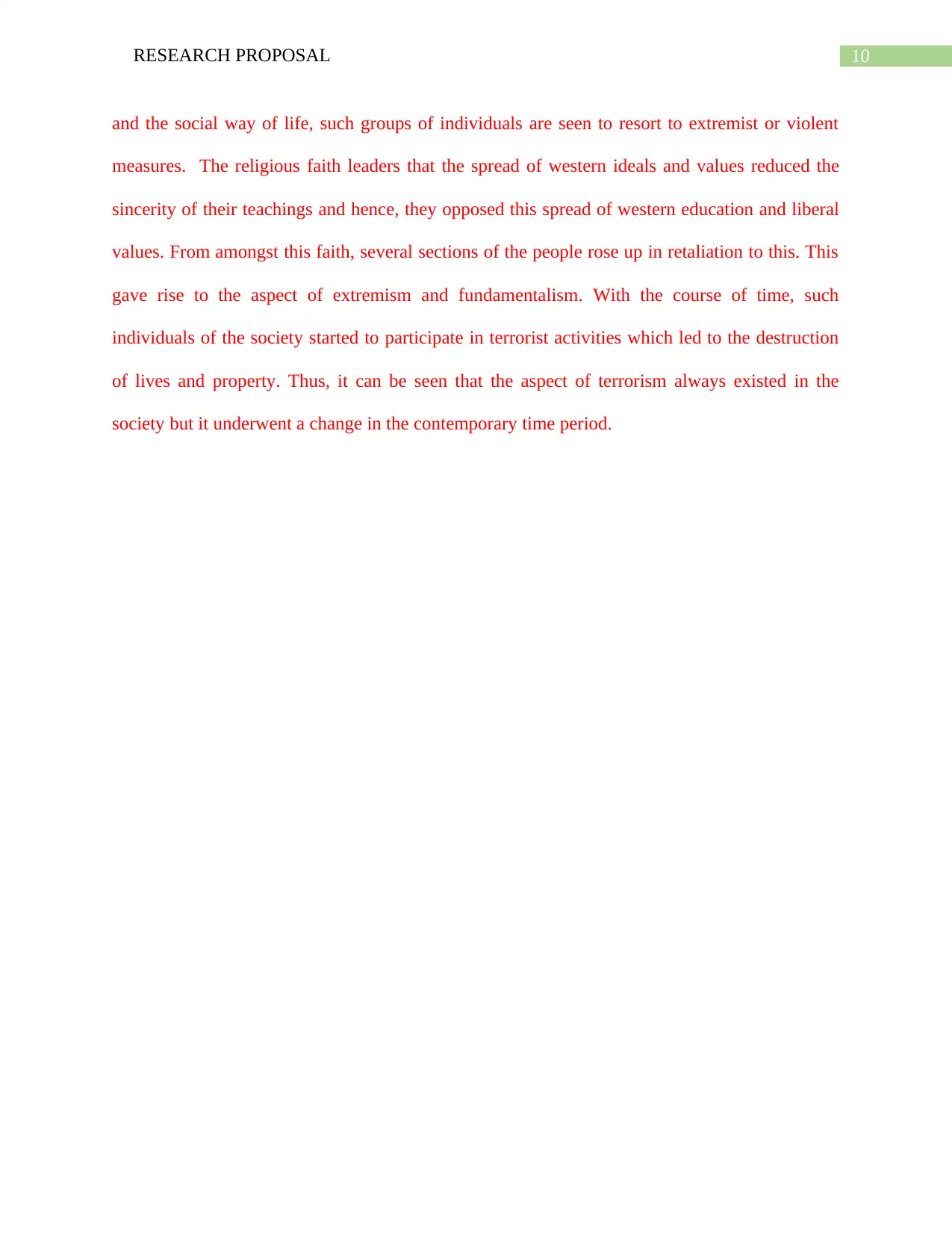
10RESEARCH PROPOSAL
and the social way of life, such groups of individuals are seen to resort to extremist or violent
measures. The religious faith leaders that the spread of western ideals and values reduced the
sincerity of their teachings and hence, they opposed this spread of western education and liberal
values. From amongst this faith, several sections of the people rose up in retaliation to this. This
gave rise to the aspect of extremism and fundamentalism. With the course of time, such
individuals of the society started to participate in terrorist activities which led to the destruction
of lives and property. Thus, it can be seen that the aspect of terrorism always existed in the
society but it underwent a change in the contemporary time period.
and the social way of life, such groups of individuals are seen to resort to extremist or violent
measures. The religious faith leaders that the spread of western ideals and values reduced the
sincerity of their teachings and hence, they opposed this spread of western education and liberal
values. From amongst this faith, several sections of the people rose up in retaliation to this. This
gave rise to the aspect of extremism and fundamentalism. With the course of time, such
individuals of the society started to participate in terrorist activities which led to the destruction
of lives and property. Thus, it can be seen that the aspect of terrorism always existed in the
society but it underwent a change in the contemporary time period.
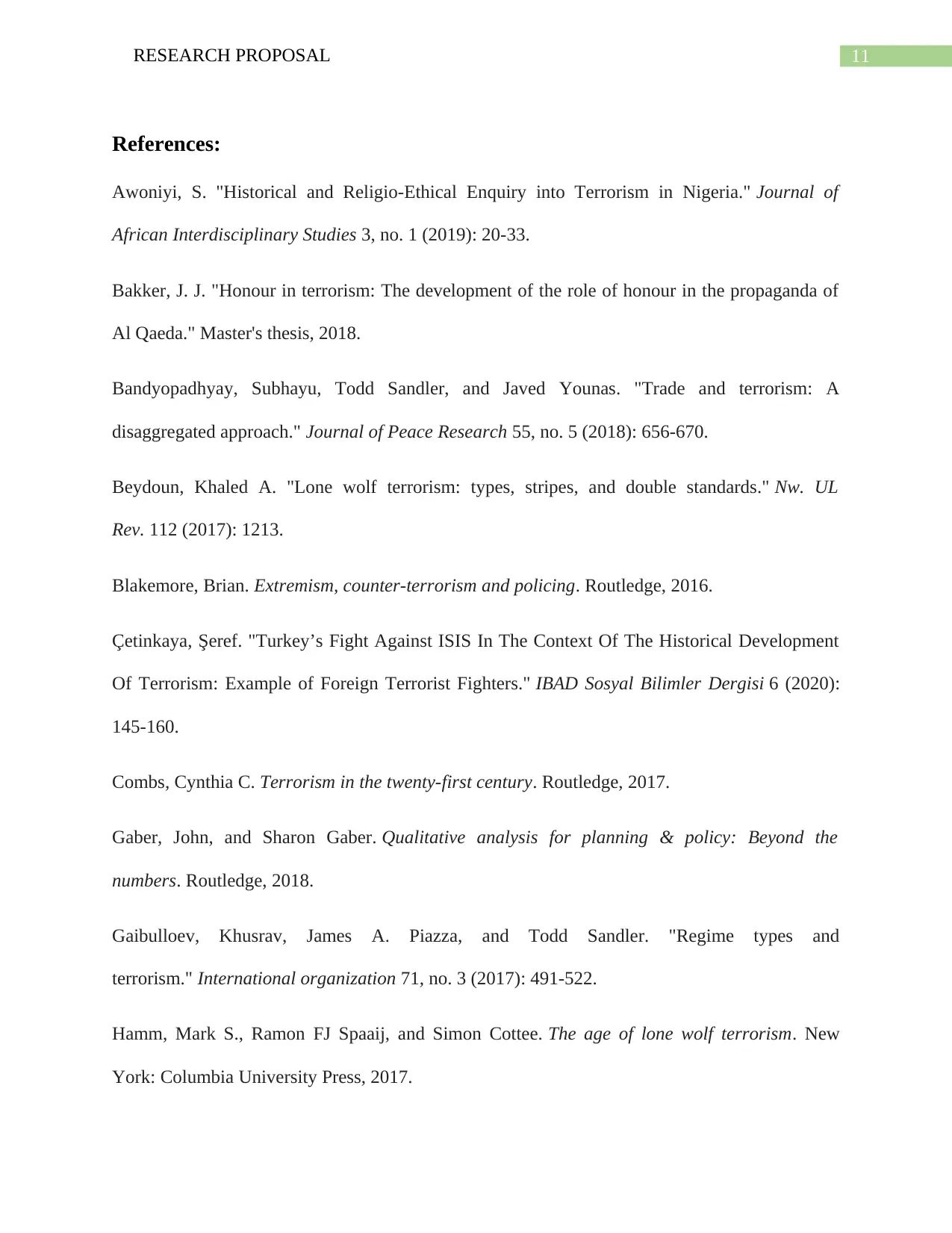
11RESEARCH PROPOSAL
References:
Awoniyi, S. "Historical and Religio-Ethical Enquiry into Terrorism in Nigeria." Journal of
African Interdisciplinary Studies 3, no. 1 (2019): 20-33.
Bakker, J. J. "Honour in terrorism: The development of the role of honour in the propaganda of
Al Qaeda." Master's thesis, 2018.
Bandyopadhyay, Subhayu, Todd Sandler, and Javed Younas. "Trade and terrorism: A
disaggregated approach." Journal of Peace Research 55, no. 5 (2018): 656-670.
Beydoun, Khaled A. "Lone wolf terrorism: types, stripes, and double standards." Nw. UL
Rev. 112 (2017): 1213.
Blakemore, Brian. Extremism, counter-terrorism and policing. Routledge, 2016.
Çetinkaya, Şeref. "Turkey’s Fight Against ISIS In The Context Of The Historical Development
Of Terrorism: Example of Foreign Terrorist Fighters." IBAD Sosyal Bilimler Dergisi 6 (2020):
145-160.
Combs, Cynthia C. Terrorism in the twenty-first century. Routledge, 2017.
Gaber, John, and Sharon Gaber. Qualitative analysis for planning & policy: Beyond the
numbers. Routledge, 2018.
Gaibulloev, Khusrav, James A. Piazza, and Todd Sandler. "Regime types and
terrorism." International organization 71, no. 3 (2017): 491-522.
Hamm, Mark S., Ramon FJ Spaaij, and Simon Cottee. The age of lone wolf terrorism. New
York: Columbia University Press, 2017.
References:
Awoniyi, S. "Historical and Religio-Ethical Enquiry into Terrorism in Nigeria." Journal of
African Interdisciplinary Studies 3, no. 1 (2019): 20-33.
Bakker, J. J. "Honour in terrorism: The development of the role of honour in the propaganda of
Al Qaeda." Master's thesis, 2018.
Bandyopadhyay, Subhayu, Todd Sandler, and Javed Younas. "Trade and terrorism: A
disaggregated approach." Journal of Peace Research 55, no. 5 (2018): 656-670.
Beydoun, Khaled A. "Lone wolf terrorism: types, stripes, and double standards." Nw. UL
Rev. 112 (2017): 1213.
Blakemore, Brian. Extremism, counter-terrorism and policing. Routledge, 2016.
Çetinkaya, Şeref. "Turkey’s Fight Against ISIS In The Context Of The Historical Development
Of Terrorism: Example of Foreign Terrorist Fighters." IBAD Sosyal Bilimler Dergisi 6 (2020):
145-160.
Combs, Cynthia C. Terrorism in the twenty-first century. Routledge, 2017.
Gaber, John, and Sharon Gaber. Qualitative analysis for planning & policy: Beyond the
numbers. Routledge, 2018.
Gaibulloev, Khusrav, James A. Piazza, and Todd Sandler. "Regime types and
terrorism." International organization 71, no. 3 (2017): 491-522.
Hamm, Mark S., Ramon FJ Spaaij, and Simon Cottee. The age of lone wolf terrorism. New
York: Columbia University Press, 2017.
⊘ This is a preview!⊘
Do you want full access?
Subscribe today to unlock all pages.

Trusted by 1+ million students worldwide
1 out of 14
Related Documents
Your All-in-One AI-Powered Toolkit for Academic Success.
+13062052269
info@desklib.com
Available 24*7 on WhatsApp / Email
![[object Object]](/_next/static/media/star-bottom.7253800d.svg)
Unlock your academic potential
Copyright © 2020–2025 A2Z Services. All Rights Reserved. Developed and managed by ZUCOL.




